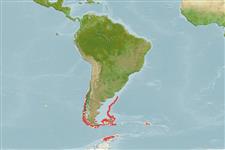Preferred temperature (Ref.
123201): 0.2 - 4.4, mean 0.9 °C (based on 8 cells).
Phylogenetic diversity index (Ref.
82804): PD
50 = 1.0000 [Uniqueness, from 0.5 = low to 2.0 = high].
Bayesian length-weight: a=0.00257 (0.00113 - 0.00587), b=3.31 (3.11 - 3.51), in cm total length, based on LWR estimates for this (Sub)family-body shape (Ref.
93245).
Τροφικό Επίπεδο (Ref.
69278): 3.7 ±0.5 se; based on size and trophs of closest relatives
Ελαστικότητα (Ref.
120179): Μεσαίο(α), ελάχιστος χρόνος για διπλασιασμό πληθυσμού 1,4 - 4,4 έτη (Preliminary K or Fecundity.).
Fishing Vulnerability (Ref.
59153): Low vulnerability (21 of 100).
Nutrients (Ref.
124155): Calcium = 30.9 [17.6, 65.1] mg/100g; Iron = 0.424 [0.204, 0.820] mg/100g; Protein = 17.7 [16.7, 18.6] %; Omega3 = 0.239 [0.119, 0.470] g/100g; Selenium = 17.3 [7.0, 39.5] μg/100g; VitaminA = 9.11 [1.88, 41.46] μg/100g; Zinc = 0.399 [0.275, 0.582] mg/100g (wet weight);
